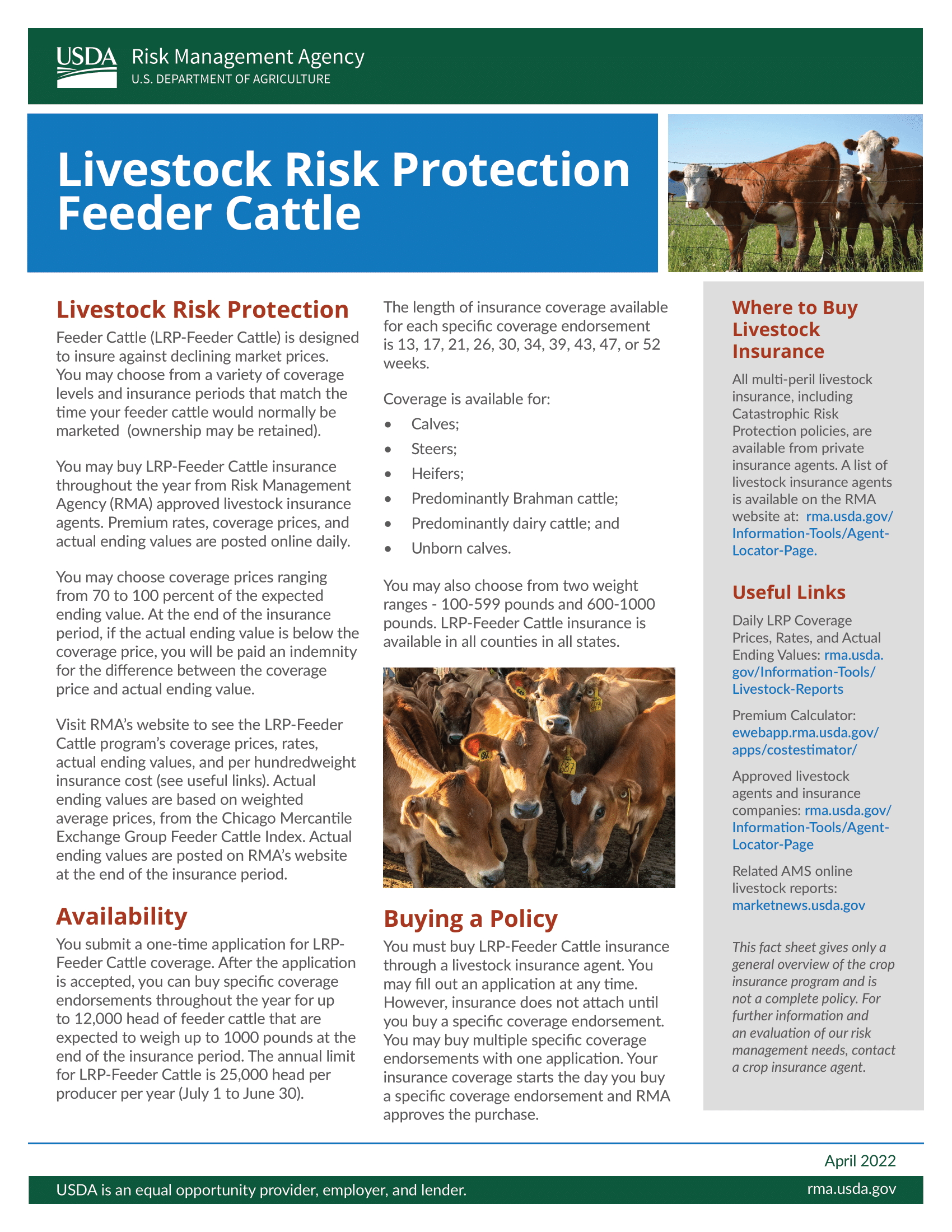Understanding Livestock Danger Defense (LRP) Insurance: A Comprehensive Guide
Navigating the realm of animals danger protection (LRP) insurance policy can be a complicated venture for numerous in the farming field. From just how LRP insurance policy operates to the numerous protection alternatives available, there is much to reveal in this comprehensive guide that can possibly form the way livestock producers come close to danger administration in their companies.

Exactly How LRP Insurance Coverage Works
Sometimes, recognizing the auto mechanics of Animals Threat Defense (LRP) insurance coverage can be complicated, yet damaging down exactly how it works can offer clarity for farmers and ranchers. LRP insurance policy is a risk monitoring tool made to safeguard livestock manufacturers against unexpected price decreases. The policy permits manufacturers to establish an insurance coverage level based upon their certain needs, selecting the number of head, weight variety, and coverage rate. When the policy remains in place, if market value fall below the insurance coverage rate, producers can sue for the distinction. It's vital to note that LRP insurance coverage is not an income guarantee; rather, it concentrates entirely on rate threat protection. The coverage period normally ranges from 13 to 52 weeks, offering adaptability for producers to select a period that straightens with their production cycle. By utilizing LRP insurance, ranchers and farmers can minimize the economic threats related to changing market costs, guaranteeing better stability in their operations.
Qualification and Insurance Coverage Options

When it pertains to insurance coverage options, LRP insurance policy offers producers the flexibility to select the coverage level, protection period, and recommendations that best match their risk management requirements. Protection degrees generally range from 70% to 100% of the anticipated ending value of the insured livestock. Manufacturers can additionally pick coverage periods that line up with their manufacturing cycle, whether they are insuring feeder livestock, fed livestock, swine, or lamb. Recommendations such as rate danger defense can further tailor insurance coverage to protect versus negative market changes. By recognizing the qualification criteria and protection choices available, livestock producers can make educated choices to manage risk efficiently.
Advantages And Disadvantages of LRP Insurance Coverage
When reviewing Animals Risk Protection (LRP) insurance policy, it is crucial for animals manufacturers to consider the benefits and negative aspects fundamental in this danger monitoring device.

Among the key advantages of LRP insurance policy is its capacity to provide security against a decline in livestock costs. This can help protect producers from financial losses resulting from market variations. Additionally, LRP insurance policy provides a level of versatility, enabling manufacturers to customize protection degrees and policy durations to fit their certain needs. By locking in an assured cost for their livestock, producers can better manage risk and prepare for the future.
One constraint of LRP insurance policy is that it does not shield against all kinds of dangers, such as disease outbreaks or all-natural disasters. It is vital for manufacturers to meticulously assess their private threat exposure and site financial scenario to figure out if LRP insurance policy is the right threat administration device for their procedure.
Comprehending LRP Insurance Coverage Premiums

Tips for Maximizing LRP Advantages
Making the most of the benefits of Animals Threat Protection (LRP) insurance coverage calls for critical preparation and aggressive danger management - Bagley Risk Management. To maximize your LRP protection, take into consideration the complying with suggestions:
Consistently Evaluate Market Conditions: Stay educated about market fads and price variations in the animals industry. By checking these factors, you can make enlightened decisions about when to buy LRP protection to secure against possible losses.
Set Realistic Insurance Coverage Levels: When choosing protection degrees, consider your manufacturing prices, market value of livestock, and prospective dangers - Bagley Risk Management. Setting practical protection degrees makes certain that you are properly shielded without paying too much for unneeded insurance coverage
Expand Your Coverage: Rather of counting entirely on LRP insurance coverage, think about diversifying your danger administration strategies. Combining LRP with other risk monitoring devices such as futures agreements or options can provide Full Report detailed protection against market uncertainties.
Testimonial and Readjust Protection Consistently: As market problems change, occasionally examine your LRP protection to ensure it aligns with your existing risk exposure. Changing coverage levels and timing of purchases can aid enhance your danger security technique. By following these suggestions, you can maximize the benefits of LRP insurance coverage and protect your livestock procedure against unanticipated dangers.
Conclusion
In verdict, livestock threat security (LRP) insurance is a beneficial tool for farmers to handle the monetary risks related to their livestock operations. By understanding how LRP works, eligibility and insurance coverage alternatives, along with the pros and cons of this insurance policy, farmers can make educated choices to protect their source of incomes. By meticulously taking into consideration LRP premiums and applying techniques to take full advantage of benefits, farmers can alleviate possible losses and ensure the sustainability of their procedures.
Animals manufacturers interested in obtaining Livestock Danger Security (LRP) insurance policy can discover an array of qualification requirements and insurance coverage options customized to their certain livestock procedures.When it comes description to insurance coverage alternatives, LRP insurance coverage offers producers the adaptability to pick the coverage degree, protection period, and endorsements that finest fit their danger monitoring requirements.To comprehend the details of Livestock Threat Defense (LRP) insurance coverage totally, understanding the elements affecting LRP insurance premiums is critical. LRP insurance policy premiums are figured out by different components, including the insurance coverage level chosen, the expected rate of animals at the end of the insurance coverage period, the type of animals being insured, and the length of the coverage period.Review and Change Coverage Frequently: As market problems alter, regularly review your LRP protection to ensure it lines up with your existing danger direct exposure.
Comments on “Opening Growth Prospective: Bagley Risk Management Approaches”